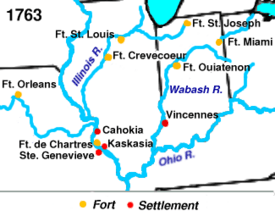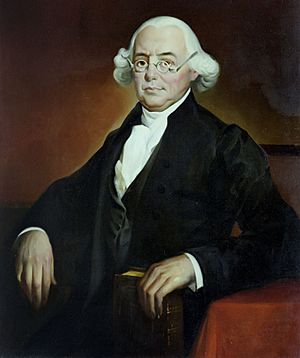Illinois-Wabash Company facts for kids
The Illinois-Wabash Company was a business formed in 1779 . It was created when two smaller companies, the Illinois Company and the Wabash Company, joined together. These companies wanted to buy large areas of land from Native American tribes in a region called the Illinois Country. This land was in North America and had become part of Great Britain in 1763.
The Illinois Company bought two big pieces of land in 1773. The Wabash Company bought two more pieces in 1775. However, the British government had a rule, the Royal Proclamation of 1763, which said that private companies could not buy land directly from Native Americans. Only the government could do this. Because of this rule, Great Britain refused to say these land purchases were legal.
Later, when the American Revolutionary War started, the Illinois-Wabash Company asked the new American government and the state of Virginia (which claimed the Illinois Country) to recognize their land deals. But they were not successful. The United States government eventually bought the land from Native Americans itself and then sold it to settlers. The issue finally went to the highest court in the country, the Supreme Court of the United States. In a case called Johnson v. McIntosh in 1823, the Supreme Court decided that the U.S. government, just like the British before it, would not recognize private land purchases from Native Americans. This meant the Illinois-Wabash Company's purchases were not valid.
Contents
Why the Land Purchases Were Denied
In the mid-1700s, many business people and land investors in the British Empire wanted to expand into the lands west of the Appalachian Mountains in North America. Companies like the Ohio Company of Virginia were set up for this purpose. But a big fight between the British and the French over this area led to the French and Indian War (1754–1763). This war stopped many of these land companies' plans.
After Great Britain won the war, the King issued the Royal Proclamation of 1763. This rule was meant to organize the huge new territories won from France. To prevent more wars, like Pontiac's Rebellion (1763–1766), the British government made it illegal for private people or companies to buy land from Native Americans. From then on, only royal officials could make treaties to buy Native American lands.
The Illinois Company's Attempt
In 1768, a group of important merchants from Philadelphia started trading in the Illinois Country. They sold supplies to Native Americans and British soldiers. In 1773, William Murray, who worked for these merchants in Illinois, heard about a British legal idea called the Camden-Yorke Opinion. This idea was misunderstood by some people in North America. They thought it meant that private purchases of land from Native Americans would now be allowed by the British King.
Thinking this was true, Murray and his Philadelphia bosses created the Illinois Company. On July 5, 1773, they bought two areas of land from the Kaskaskia, Peoria, and Cahokia tribes.
The Wabash Company's Attempt
British officials quickly said that the Illinois Company's purchase was not legal. The way the Camden-Yorke Opinion was understood in America was wrong. In April 1774, William Murray asked his relative, Lord Dunmore, who was the Royal Governor of Virginia, for help. Lord Dunmore agreed to support the company's land purchases if he got a share of the profits.
So, Murray formed the Wabash Company, and Lord Dunmore became a member. On October 18, 1775, an agent for the Wabash Company bought two areas of land along the Wabash River from the Piankeshaw tribe. This was called the 'Piankeshaw Deed'. However, the American Revolutionary War began soon after. Lord Dunmore was forced to leave Virginia. This meant the companies had to find new officials to recognize their land purchases.
The Companies Merge and Face New Challenges
During the American Revolutionary War, the British had very few soldiers in the Illinois Country because it was far from the main fighting. In July 1778, Colonel George Rogers Clark and a small group of soldiers took control of the region for Virginia. Virginia claimed the entire Illinois Country because of its old colonial charter.
In December of that year, William Murray presented a request to the Virginia government, telling them about the land claims of the Illinois and Wabash companies. To make their efforts stronger, the two companies joined together on March 13, 1779. They became the United Illinois and Wabash Land Company. Important Americans like James Wilson and Robert Morris, who had invested in the company, supported their cause. Other famous members included Silas Deane, Samuel Chase, and Maryland governor Thomas Johnson.
Virginia and the U.S. Government Say No
Even with these powerful connections, Virginia refused to recognize the Illinois-Wabash land purchases. Instead, Virginia created the "County of Illinois" in November 1779, claiming the land for itself. Since Virginia rejected them, the company then tried to convince the new national government of the United States.
This issue became part of a bigger discussion in Congress about the western borders of states. States that did not have western lands wanted Virginia and other states with large land claims to give these lands to the national government. Virginia eventually gave its western land claims to the United States in 1784. Despite many requests from the Illinois-Wabash Company, which continued into the early 1800s, the U.S. government also refused to recognize their land claims. The company slowly disappeared.
The Supreme Court's Final Decision
The United States government eventually bought the lands in question from Native Americans through treaties made by William Henry Harrison. After the War of 1812, the United States began to give out official land ownership papers to settlers. In 1820, the person in charge of the estate of an investor in the Illinois-Wabash Company sued William McIntosh, who was one of the biggest new landowners. The lawsuit claimed that McIntosh had bought land that rightfully belonged to the Illinois-Wabash Company, based on their earlier purchase from the Native Americans.
In 1823, this case reached the U.S. Supreme Court in a case called Johnson v. McIntosh. The Court decided in favor of McIntosh. They ruled that private purchases of Native American lands were not valid. This decision brought an end to the story of the Illinois-Wabash Company.



